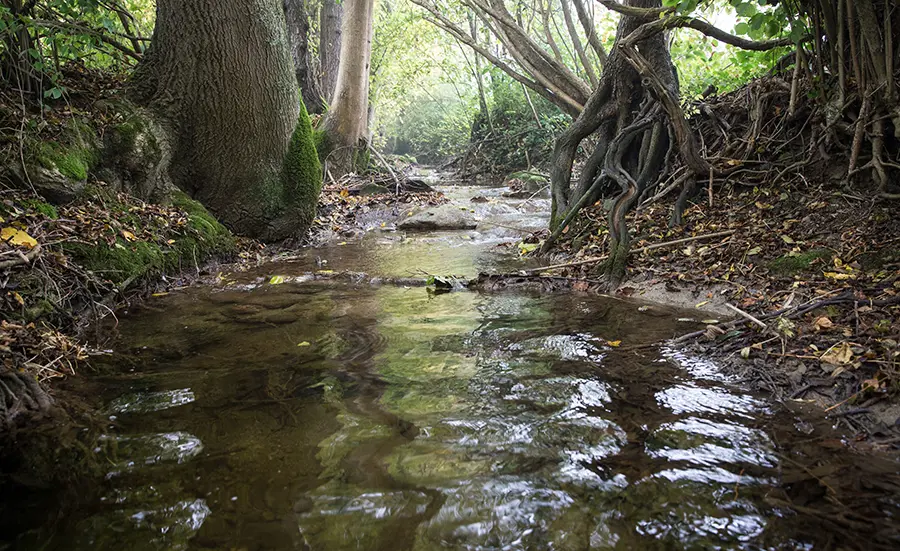
Pesticides in Swiss streams: much remains to be done
Three recent studies examine pesticide pollution in Swiss streams and rivers. With comprehensive screening of over 250 pesticides, they show which of them occur in water bodies and which pose the highest risks to aquatic organisms The studies also investigated the applications from which particularly risk-relevant pesticides originate and the routes by which they enter water bodies – an important basis for reducing the pollution of water bodies by these substances in a targeted manner. Eawag, the VSA Platform Water Quality and the Ecotox Centre worked together in these investigations.
Authors: communication Eawag
Many watercourses in Switzerland contain concentrations of pesticides that are harmful to aquatic organisms. Depending on the active ingredient, they are used as plant protection products, as biocides to protect people and materials, or as veterinary medicines. Individual active ingredients (especially insecticides) are also used for several of these applications. Although much is already known about the input of pesticides, especially plant protection products from agriculture, there are still some knowledge gaps. For this reason, the aquatic research institute Eawag, the VSA Platform Water Quality and the Ecotox Centre have taken a close look at water pollution with pesticides and their causes in three different studies that have just been published in the journal Aqua & Gas.
Pesticide risks are recorded in the national watercourse monitoring programme
One aim of the investigations was to find out which pesticides occur in Swiss watercourses in concentrations that endanger aquatic organisms. For example, the research was intended to determine whether all risk-relevant pesticides are recorded in the national watercourse monitoring programme for micropollutants ("NAWA TREND MV"), which currently analyses 73 pesticides in 38 watercourses throughout the year. In a special measurement campaign ("NAWA SPEZ 2023") from March to November 2023, 14-day composite samples were therefore taken from five selected watercourses and analysed for a broad spectrum of 253 pesticides.
The results show that national monitoring effectively covers those pesticides that cause water risks. Of the 253 pesticides analysed, 135 were detected in the five watercourses, 23 of them in concentrations that pose a risk to aquatic organisms. Most of these substances which are responsible for the risk are insecticides, in particular pyrethroids and fipronil, while herbicides play a minor role. However, pesticides were also detected that are not investigated in the national watercourse monitoring programme for micropollutants and for which the risk to aquatic organisms could not be conclusively assessed by the Ecotox Centre as part of the study. These should therefore be better analysed.
Multiple entry routes into water bodies
To be able to reduce the input of pesticides into water bodies, it is necessary to know which applications they originate from and which routes they take when entering the water bodies. In the catchment area of each of the five watercourses analysed in the special measurement campaign, there is a wastewater treatment plant without a treatment stage for the removal of micropollutants. Samples were also taken from the effluent of these plants to quantify the proportion of pesticides entering the analysed water bodies via wastewater treatment plants.
In addition, the five-year data series of the national watercourse monitoring programme was analysed for the ten pesticides that currently pose the greatest risks to aquatic organisms in watercourses. Moreover, the research considered information on sales volumes of selected biocides and veterinary medicines; this information has been available since this year but is still incomplete in some cases. As a result, it was possible to narrow down the applications and entry routes that are decisive for these particularly risk-relevant pesticides.
The findings show that pesticide entry routes can vary greatly depending on the active ingredient and the watercourse. Most pesticides are introduced both via wastewater treatment plants and via other entry routes – such as leaching due to rain. However, the entry routes can also differ between water bodies. This is also true for the particularly risk-relevant pyrethroid insecticides.
For some pyrethroid insecticides, in addition to their use as plant protection products, their use as biocides in outdoor areas and as veterinary medicines can also be relevant for water pollution. For example, parasite control in livestock is probably relevant with respect to permethrin contamination in water. Lambda-cyhalothrin, on the other hand, comes almost entirely from applications as plant protection product.
Tick and flea products for pets: the most likely source of the insecticide fipronil
Fipronil is a special case. The data shows that it is continuously discharged into water bodies throughout Switzerland via wastewater treatment plants, where it poses a high risk to aquatic organisms. In the national monitoring data, it was the pesticide that most frequently exceeded ecotoxicological quality criteria in 2022 and 2023. The most likely source of the fipronil inputs is its use as a tick and flea repellent for cats and dogs. The active ingredient can adhere to hands, animal hair and textiles and may thus enter the wastewater treatment plant and water bodies through washing.
Closing knowledge gaps
The studies have provided important insights into the entry ways and relevant applications of pesticides in watercourses and revealed where knowledge gaps still exist. In this way, they make an important contribution towards targeted measures to reduce water pollution.
Publications
Schorr, J., Ganz, V., Luong, K., Ceppi, E., Longree, P., Beck, B., Singer, H., Barth, S., Doppler, T., Junghans, M., & Holmes, B. (2025). Pestizideinträge in Fliessgewässer. NAWA Spez 2023: Wirkstoffe, Ökotoxikologisches Risiko, diffuse Eintragspfade vs. Einträge aus ARA. Aqua & Gas, 105(10), 70-78. Institutional Repository: https://www.dora.lib4ri.ch/eawag/islandora/object/eawag:35500
Barth, S., & Doppler, T. (2025). Ursachen der Pestizid-Verunreinigung. Mögliche Quellen und Eintragswege in Fliessgewässer eingrenzen. Aqua & Gas, 105(10), 80-88. Institutional Repository: https://www.dora.lib4ri.ch/eawag/islandora/object/eawag:35502
Barth, S., Doppler, T., Ganz, V., Luong, K., & Singer, H. (2025). Fipronil belastet die Fliessgewässer. Antiparasitäre Tierarzneimittel für Heimtiere als wahrscheinlichste Quelle. Aqua & Gas, 105(10), 90-95. Institutional Repository : https://www.dora.lib4ri.ch/eawag/islandora/object/eawag:35504